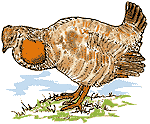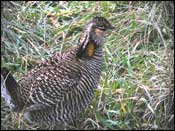Attwater's Prairie Chicken
Attwater's Prairie Chicken is making a comeback!
In 2003, there were fewer than 50 birds in the wild. In just 6 years, despite challenges including several major hurricanes, the population has reached 90 birds in three populations. You can help this trend continue.
A milestone is reached! This year, six hens in two different populations raised twenty-one chicks to at least six weeks age. Two of these hens did so with no help from staff or interns at the Attwater's Prairie Chicken National Wildlife Refuge! With your help, these trends can continue.
Introduction
A what? You're worried about an endangered chicken?
This is often the reaction of people the first time they hear about the most endangered bird in the state of Texas. But the Attwater's Prairie-Chicken is much more than "just a chicken."

The Attwater's Prairie-Chicken is a member of the North American grouse family. Slightly smaller and darker than it's close relative the Greater Prairie-Chicken, this southern subspecies of the now extinct Heath Hen once roamed an extensive range on the coast of Texas and Louisiana. Today, the bird is limited to two small, isolated colonies in two counties along the Texas coast.
What is unique about this bird?
Like most birds, the most colorful time of the year for Attwater's Prairie-Chickens is the spring when the males gather on "leks", large short grass areas on the coastal prairie.

Attwater's Prairie Chicken
The males at this time inflate their air sacs, raise their tails in the air, droop their wings, and dance around, stomping their feet. This is accompanied by a low, mournful whirring sound called "booming". Intermittent jumps and charges at other males accompany the booming activity which reaches its peak when a female ventures into the lek. This dance is said to have been the source of many of the dances of the native peoples of the American prairie.
So, what does an Attwater's Prairie-Chicken look like?
Wildlife Conservation Program
Texas Parks and Wildlife Department
4200 Smith School Road
Austin, TX 78744
or send a message to: nature@tpwd.texas.gov